 The Italian cold war navy
The Italian cold war navy
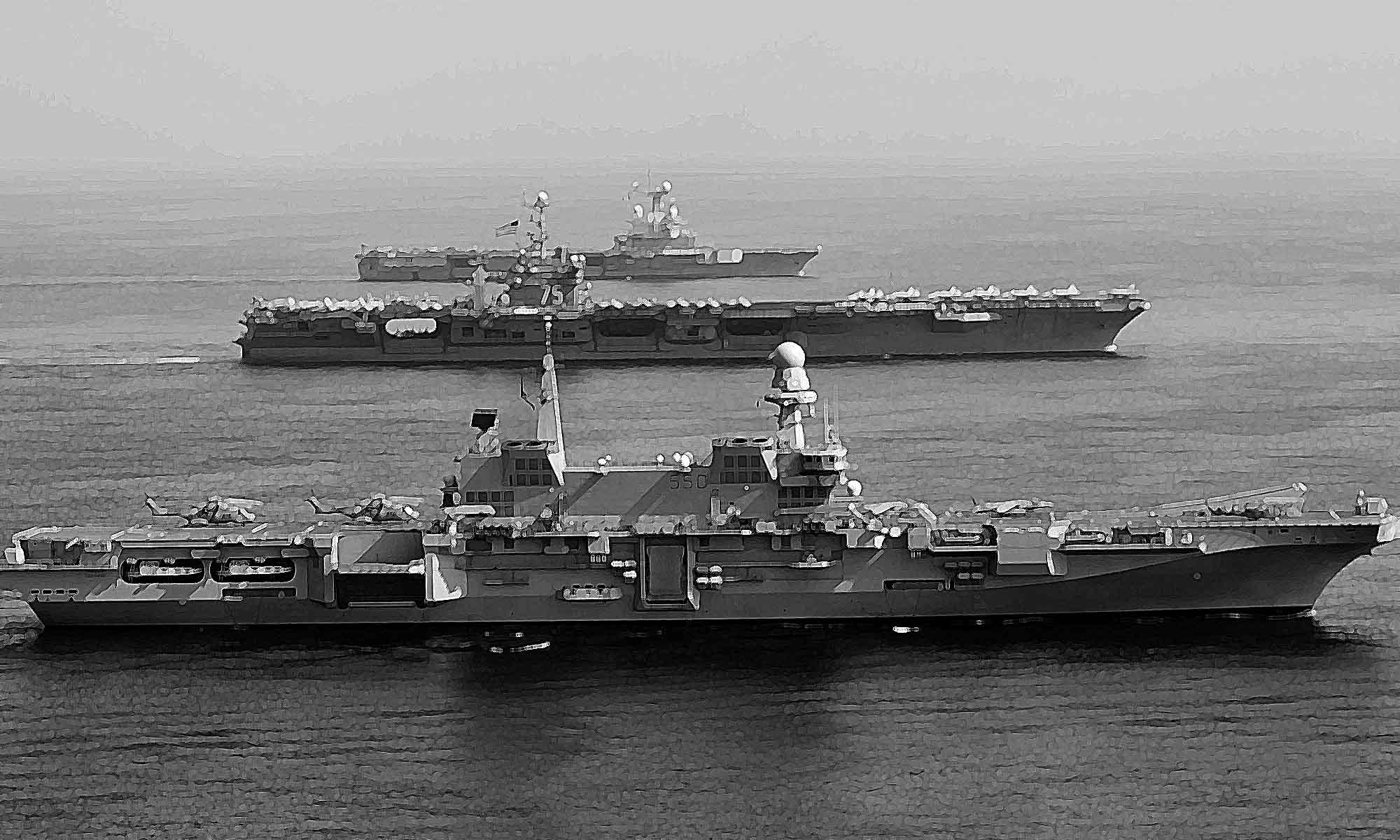
Mediterranean NATO might: Italian aircraft carrier Cavour in the Gulf of Oman, 2013, with the USS Harry S. Truman (CVN 75, 5th fleet) and the French navy aircraft carrier Charles de Gaulle in the background, Task Force 473.
Born from the Regia Marina in modern, post-war Italy, the Marina Militare (Litt. “military navy”) is today one of the pillars of the Mediterranean NATO’s strength, with France. Both navies are today collaborating on frigates while being at the same time fierce exporters. The Italian Navy went on innovating, capitalizing both on design traditions and tackling helicopter and aircraft carriers as well as cruisers and assault ships with the same enthusiasm.
The Italian cold war navy was a quite versatile force, equipped to deal with ASW as well as surface/AA threats, and although not provided with the equivalent of AEGIS found on Spanish destroyers, still possesses first-class electronic providers and equipment. Nevertheless, the country considerably benefited from the Marshall plan, which supported the rebirth of a naval industry, not only to cover the Navy’s needs but also NATO, as building cost was cheaper than in France or UK.
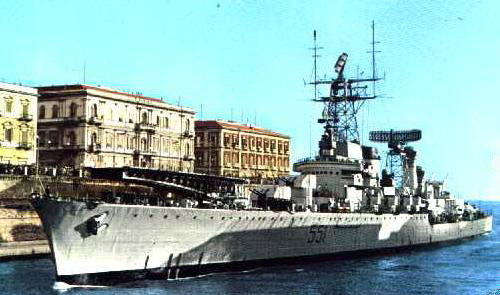
The missile cruiser Garibaldi in 1961. She was the former 1936 Duca Degli Abruzzi class cruiser, already modernized in the 1950s.
Strength at the end of the cold war
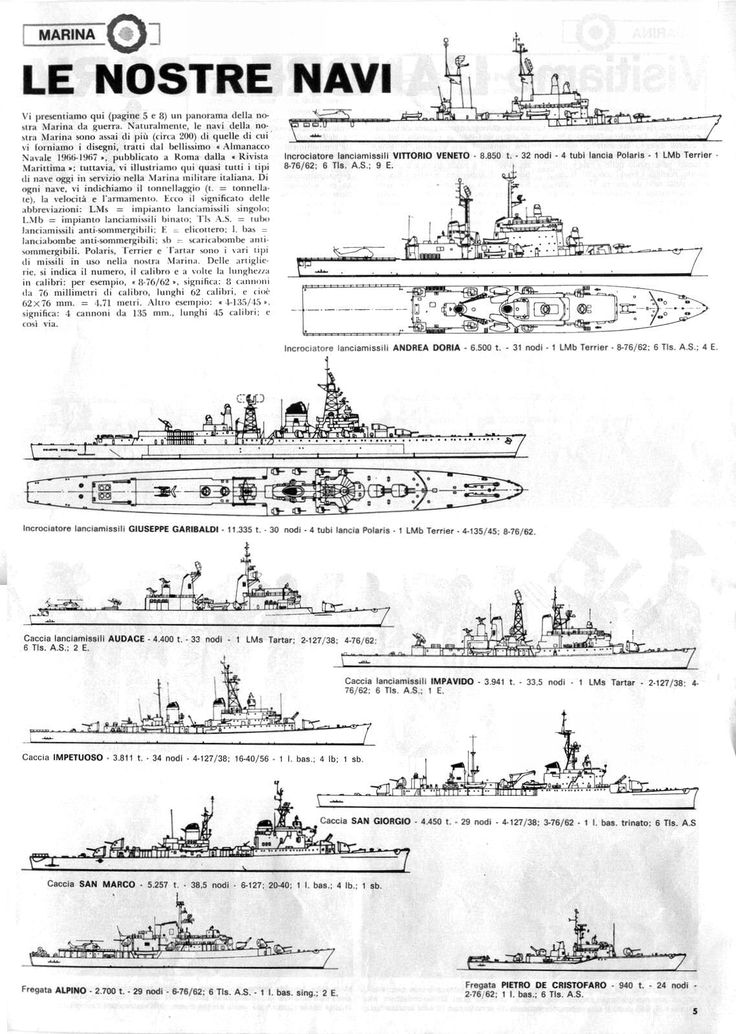
In 1990, the Italian navy aligned a considerable fleet:
- An aircraft carrier: Guiseppe Garibaldi (1983)
- Three helicopter cruisers: Andrea Doria class (1962) and Vittorio Veneto (1967)
- Four destroyers (two more launching): Impavido (1962), Audace class (1971)
- Eighteen Frigates: Alpino (1967), Lupo (1976), Maestrale classes (1981)
- Fifteen corvettes: Albatros (1954), De Cristofaro (1965), Minerva class (1987)
- Ten diesel attack submarines: Toti (1967), Sauro (1976), Pelosi class (1986)
- Three assault dock landing ships San Giorgio class (1987)
- Ten LCVP landing crafts, Fifteen LCM, three Quarto class (1967)
- Seven Sparviero class hydrofoil FACs (1980)
- Twenty Aragosta class coastal minesweepers (1955)
- Four Lerici (1982), eight more Gaeta class minehunters on order

Published & Upcoming posts
- Aircraft Carrier Giuseppe Garibaldi (1983)
- Albatros-class Corvette (1954)
- Audace class destroyers (1971)
- Doria class helicopter cruisers (1962)
- Impavido class destroyers (1962)
- Impetuoso class destroyers (1952)
- Luigi Durand de la Penne class destroyer
- Missile cruiser Garibaldi (1960)
- Pietro de Cristofaro class Corvette
- San Giorgio class LHDs (1987)
- Vittorio Veneto helicopter cruiser (1967)
Destroyers
De La Penne class (1989)
Frigates
Grecale class (1949)
Canopo class (1955)
Bergamini class (1960)
Alpino class (1967)
Lupo class (1976)
Maestrale class (1981)
Corvettes
Albatros class (1954)
De Cristofaro class (1965)
Minerva class (1987)
Cassiopeia class (1989)
Submarines
Toti class (1967)
Sauro class (1976)
Pelosi class (1986)
Longobardo class (1992)
Attack/Amphibious ships
San Giorgio LSD (1987)
Misc. ships
Folgore PB (1952)
Lampo class PBs (1960)
Freccia class PBs (1965)
Sparviero class GMHF (1973)
Mine warfare ships
Lerici class (1982)
Gaeta class (1990)
NATO areas of operations
The Italian cold war navy had to operate on the two Mediterranean basins (each side of Sicilia) and the narrows of the Adriatic. In particular, their presence in Adriatic was to answer a theoretically neutral Yugoslavian navy, the Albanian Navy (with a Soviet submarine base), the Bulgarian Navy, also part of the Warsaw Pact whereas Turkey showed throughout its independence and had the Bosporus straight potentially closed to the Soviet black sea fleet.

Soviet helicopter cruiser Moskva operating with the 5th Eskadra in the Mediterranean (Imperial War Museum coll.)
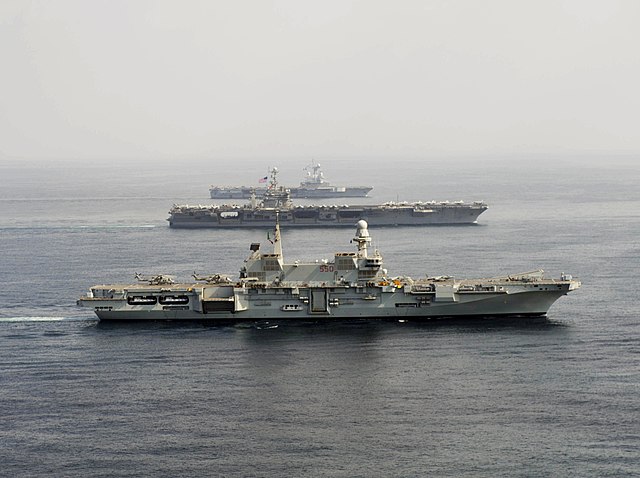
In fact the latter did ventured in the Mediterranean on a regular basis during the cold war. The 5th Operational Squadron went on with a collection of operational bases. However, there was never the same kind of “dangerous game” submariners in particular were accustomed for in northern waters, of strategic importance. From 1969 however, Libya became a potential threat was aligning with the Soviet block and subjected to be potentially used as a Soviet base, right at the doorstep of the Italian boot.
During the cold war, the Mediterranean was a complex theater of operations, compounded by the presence of massive Soviet airbases, with strategic bombers and naval long-range patrol planes. In 1969, they added a presence both in Libya and Egypt, considerable strategic assets for the control of the Mediterranean. The Marina Militare for air cover in the 1970s still depended on land-based aircraft.
All three helicopter cruisers were tailored for ASW warfare and the air group of the Garibaldi, made of Harriers, had from 1986, the only real naval air asset in the region, outside a comparable one by Spain (Principe de Asturias). Yet at the very end and after the cold war, and despite budget cuts, activity did not flinch as control of the EEZ and in particular immigration became the focus of the Italian Navy.
The Regia Marina in 1945
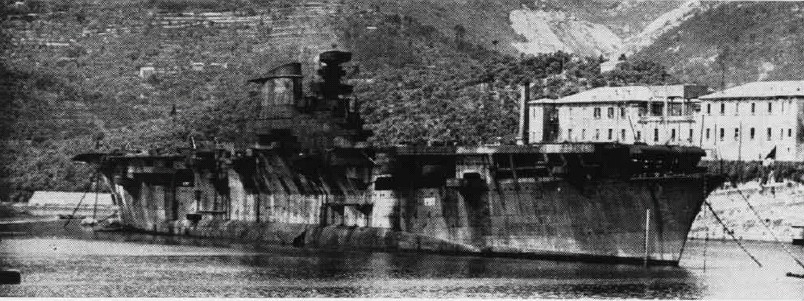
CV Aquila, almost completed in 1943, waiting to be scrapped at La Spezia in 1951.
After being part of the Axis operations until September 1943, the Regia Marina was very active, yet registering more defeats than successes, partly due to the lack of radars, adequate AA, and coordination with land-based aviation. September was a tragedy that saw part of the fleet sank by the former ally, Germany, or captured and later pressed into service either under German colors or their allies, like Croatia of the Salo Republic. The rest of the fleet, which took refuge at Malta, joined the allies and participated in many operations until V-day in Europe.
After 1945 it was assumed part of the Italian fleet was to be attributed as war prizes. A Battleship was sent to USSR, two cruiser and some destroyers to the French, or TBs to the Yugoslavians. However surviving ships were maintained in service like the ww1-vintage, but modernized Battleships Caio Diuilio and Andrea Doria, acting as training ships, and the cruisers of the Garibaldi class, the latter being transformed as a missile cruiser in the 1960s. Some submarines and numerous MAS-boats also assured the interim, waiting NATO-backed transfers of British and American ships, and the first local shipyards constructions, from 1950 onwards.

Part of the only two surviving destroyers of WW2, the Granatiere (D550) was modernized and extensively used until 1958, like the Carabiniere (1965). Credits Marcello Rigoso src
Italy ended ww2 as a co-belligerent of the allies, but still a very ambiguous position like all nations that swapped side during this war. Under the 1949 treaty, Italy was forbidden any aircraft carrier, battleship (but the two Doria kept as training units), however with the specter of a communist takeover in Greece, Italy was soon included in plans for a revived, strong navy.
Among other modification in the meantime of NATO, US and British transfer, the Italian cold war navy had to make due with submarines disarmed and used as battery-charging vessels while torpedo boats saw their TTs removed and were used as patrol gunboats.
At this point Italian economy proved unable to provide the required ships. But through the Marshall plan, Italian shipyards were heavily subsidised and set up to new US-driven production standards. This was done through an ambitious 5-year building programme laid out in 1950 (see later).
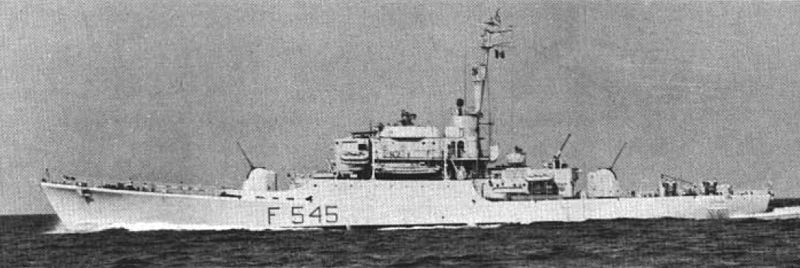
Italian corvette Airone underway circa 1962, Albatros class. (cc)
1949: The Marina Militare joined NATO
In 1949; Italy soon joined the organization, as UK and the US were already well embroided in the Greek civil war, a contest to see if the cradle of Western civilization was to fall too into Moskow’s orbit. Maintaining an effective Italian Navy at the doorstep of the Balkans was all too logical and desirable.
Therefore not only the new regime gradually started, well helped by the Marshall plan, to rebuilt a naval force with its shipyards dependencies and related industry. Whereas a patrol force was made of torpedo boats converted to gunboats and submarines retained to battery-charge other vessels, initial prohibitions about both types of ships -and aircraft carriers- were dropped in 1952.
New 1950 naval Plan
While the Marshall plan consisted in a five-year reconstruction plan of European shipyards laid out in 1950, an early Italian plan called for a 6000 ton cruiser, two 4000 ton AA cruisers, and six versatile 2500 ton destroyers, a prototype 1500 tons ASW escort and a fleet of MGBs plus patrol crafts.
It was practical for the AA cruisers, to modernize the recent Capitano Romani ships still available, and for the two 6000 tons cruisers, modernizing the two Garibaldi class cruisers was also found more economically sound than trying to venture into new constructions. However after some time and with US help, new Italian units were built: The large Canopo class frigates, and Albatros class corvettes (with five extra built for other NATO members).
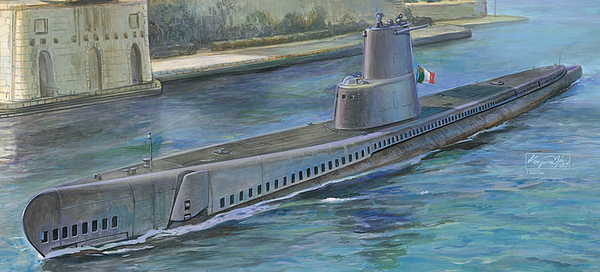
One of the many GUPPY type submarines provided by the USN, Leonardo Da Vinci (artist impression, AFV Club kit)
Ships built within this 5-year programme were armed with US weaponry and sensors. However an Italian ASW mortar was also developed. A plan for converted 21-in tubes firing wire-guided ASW torpedoes was never completed and the tubes never fitted. In the realm of fast attack crafts, Italy devised a brand new generation well ahead of the old MAS concept and these early successes drove forwards the early development of missile-armed hydrofoils.
US Transfers consisted in two GUPPY-III fast submarines in 1954-55 and two Benson class destroyers, which had some influence over coldwar Italian destroyer designs. The GUPPYs were soon joined bu three suviving ww2 submarines took over to be streamlined and modernized, and three prewar destroyers modernized while many wartime ASW corvettes were maintained as interim escorts.
Second 5-year naval Plan
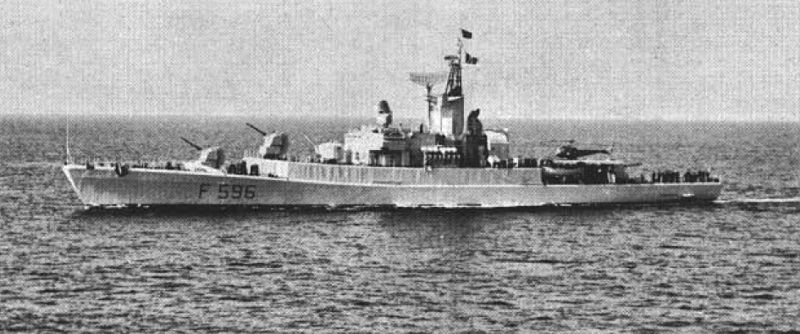
Luigi Rizzo, a Bergamini class Frigate circa 1962
Italian shipyards meanwhile went on providing additional ships for NATO, perfecting skills and bringing much needed cash: Ansaldo in particular designed a light corvette and light destroyer designs for Denmark and the Netherlands, and Frigate for Portugal through NATO purchasing system.
The Lupo class frigates were exported, Wradi M’Ragh corvettes built, and exports until the 1980s through Iraqi needs.
Through this combination of subsidised constructions and technology transfers the Italian Fleet grew to one of the most modern and capable in the Mediterranean outside France in the 1980s.
The second 5-yer program brought more modern sensors and missile tech to Italy, and in 1957 the Impetuoso was the first Terrier-launcher destroyer in Europe, and world’s second after the USN Charles F Adams. This plan was followed by brand new ships, the Enrico Toti submarine, Bergamini corvettes and starting the same year a long study for an helicopter cruiser. The same year also Garibaldi was being rebuilt as a missile cruiser, for the needs of the Italian cold war navy;
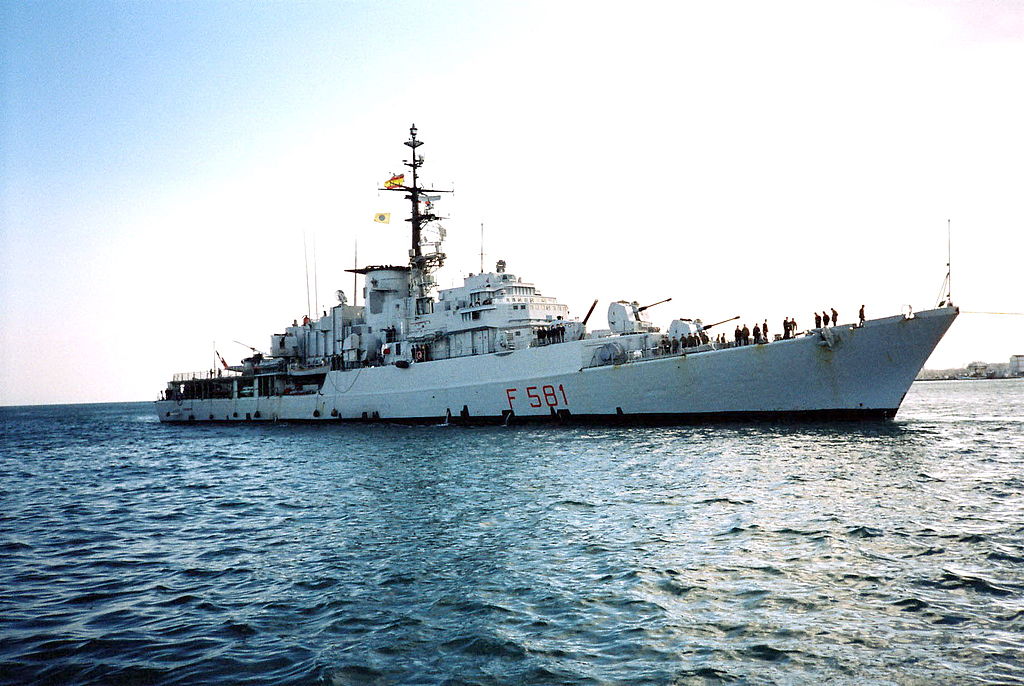
Carabiniere, an Alpino class ASW corvette of the 1960s.
The last years of the second plan in 1959-61 shown new escort vessels built (Circe class) and Alpino class. Also the helicopter carrier idea was finally dropped but the two missile cruisers of the Doria class were built instead, both with a considerable ASW helicopter installations, making them quite interesting hybrids. A third, the Dandolo, was cancelled and the design modified to end later with the large Vittorio Veneto. During this program, the rebuilding of Pietro Calvi shown many similarities with the GUPPY and British conversions.

Submarine Enrico Toti, a landmark in the Italian Navy (now preserved).
One of the most spectacular project of 1960 was the Gugliemo Marconi SSN. It is unclear of US Authorities were contacted at this point, but just like the Poseidon type missiles, this was dropped entirely in 1960. However the USN provided more GUPPY submarines and 4 ocean minesweepers plus 17 coastal minesweepers and financed the construction of many more vessels for coastal/inshore minesweeping. In 1957 already this fleet comprised 56 vessels.
Italian plans of the sixties
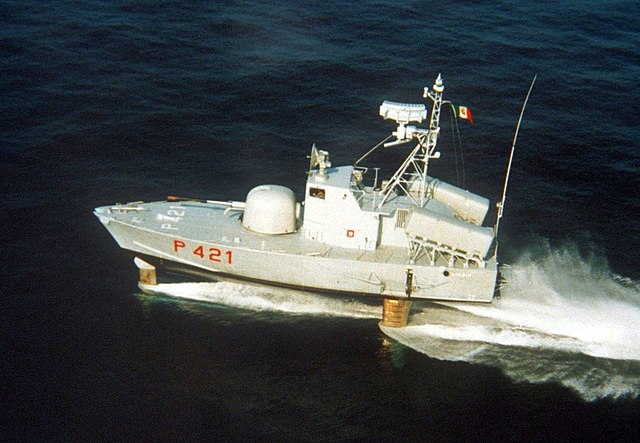
In 1967 a new construction program was launched, with two 1400 tons submarines, a fourth missile cruiser (later cancelled), two Audace class DDs, two large frigates and one corvette, three Quarto class LSTs, four small ASW subs and two more GUPPYs. In 1970 that made ten.
Part of the program was cancelled in 1968, and some ships restored in the early 1970s. In 1970 also, the Italian cold war navy commissioned its first (and only) missile hydrofoil, the Sparviero.
The Lupos designed evolved and were of a capacity close to regular destroyers. A distinction was made for both types, as Frigates were more ASW-specialized and destroyers SAM and anti-ship specialized. There was no US-style task-force indeed and therefore no ship-borne antiship capabilities, the missile cruisers provided instead the muscle by their own vectors and an extra length for ASW making a powerful ‘area cleaning’ combination.
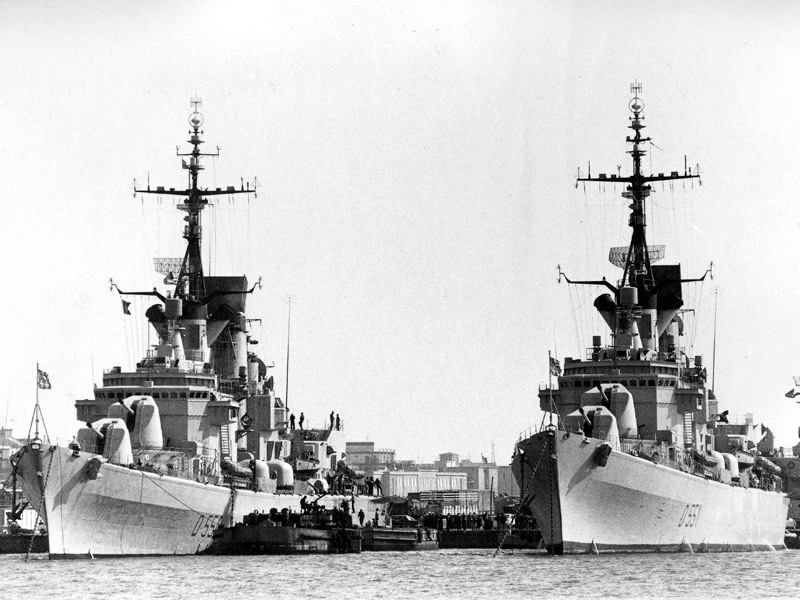
Ardito and Audace, the new 1970s fleet missile destroyers.
In 1974 this fleet was already ageing, and a white paper preconised some replacements, as without it, the fleet would be halved by 1985. These recommendations were enshrined in 1975 and passed into a naval law; and a ten-year long replacement program was started. Part of this plan which also included the building of Audace, Lupos, more Sparviero (and larger 250 tons hydrofoils) and Sauro class subs, plus modernizations, including minesweepers converted into mine-hunter (much more costly).
But budget cuts meant some of the ships were never delivered; Instead, the USN provided as late as 1975 two more GUPPYs and two Tang class subs, to maintain the goal of having ten modern fleet submarines. This level was maintained until 1993 and rising costs cut it to eight. Meanwhile the helicopter capability was maintained with partly locally-built models, based on US tech, and these shipboard helicopters were provided with ASW and antiship missiles as well.
The Marina Militare great replacement plan 1981-1990
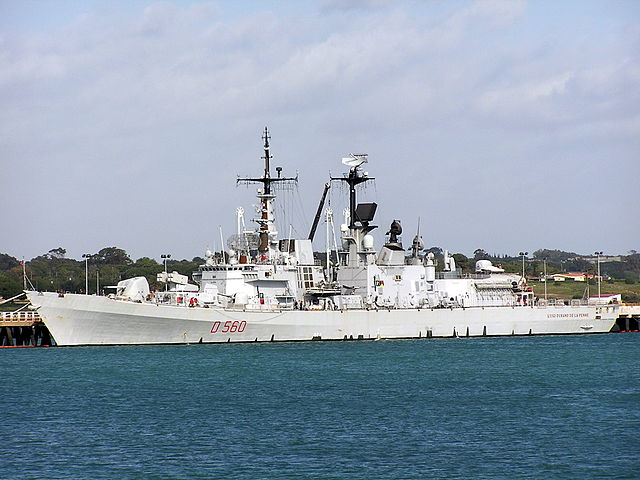
Luigi Durand de la Penne, symbol of the late cold-war Italian Navy. A large (and costly) AAW destroyer which is the backbone of a battlegroup (1990).
In 1981 a new white paper argued for a fleet comprising two light carriers, six missile destroyers, twenty frigates and corvettes, a large training vessel, ten FACs, 24 minehunters, three supply ships, three new maritime patrol squadrons. The goal was to have two task forces, one for the Western and Eastern Mediterranean basins. This fleet configuration survived until 1990, but the battlegroup shrinked to two DDs and four FFs around each carrier.
Older Frigates were to provide individual area protection at long range, operating individually. However with the end of the cold war, plans for a second carrier, to be names Guiseppe Mazzini, were cut. In the later 1990s, with the growing costs of AAW, agreements were passed with the Marine Nationale (French Navy) for a common large versatile stealthy frigate (which became the Orizzonte program). One of the interesting idea to gather more coast guards was to devise a financing plan with non-state funds, but it was never to be.
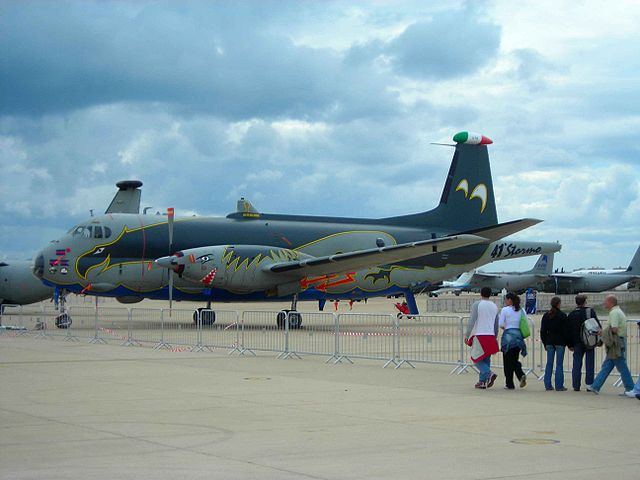
Italian Breguet Atlantique 2
The Italian cold war fleet air arm was developed thanks to US help, starting with a single squadron of Curtiss SB2C Helldiver in 1949, PV-2/harpoon bombers, and in 1955 S2F1 Trackers ASW patrol planes, and in the 1970s, Breguet Atlantic from France, with two Sqn in 1973, and later Atlantique Mk.2 planned FY 1975 to replace the Trackers, but it was never to be.
There was a prospect to purchase the P-3 Orion, but it never materialized and the Breguet squadrons were modernized to the Mark 2 instead. Later the fleet air arm was completed by four squadrons of Tornados, one of G-91Y and three of AMX. All were capable of carrying anti-ship missiles, the Tornados were given the long-range Kormoran.
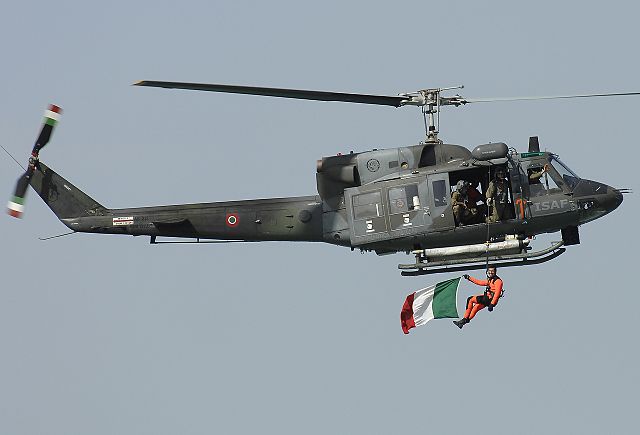
Italia Agusta-Bell AB 212 of the Marina Militare
Italian electronics
On the electronic side, Selenia was created as a consortium, producing in Italy Radars and sensors, but also missiles, like the Aspide system. It was also responsible later for the SADOC system, based on the US NTDS system. In the early 1960s Link 11 was adopted, placing Italy on par with the best US and French units in the Mediterranean. This was seen as a necessity for closer relations with the USN sixth fleet and cooperation. SADOC was also fitted in many frigates.
There was no such thing that a fully-fledge third 5-year plan. The 1960s were therefore occupied with filling the blanks and gaps left by the older equipments and those to complete all areas the navy needed. Also in 1962 the De Cristofaro class corvettes were ordered. At the end of this process the Navy had three missile cruiser with extensive helicopter capabilities, two destroyer leaders (mod San Giorgio), four (two missile) destroyers, six ASW Frigates, twelve corvettes, eight Snorkel submarines plus older Gabbiano class corvettes.
In the 1950s, Italy already had experiences companies: OTO was the reunion of three older companies, Odero-Terni-Orlando. Breda excelled with guns and mountings, and Whitehead already well present for torpedoes and addimilated hardware, whereas Officine Galileo was the equivalent of Zeiss in germany, specialized in everything optical.
An actor was missing, and that was a creation by the government, MicroLambda, specialized in electronics and marine radars. It became later a department of the larger group Selenia, while later another private actor, Elettronica, specialized in EEW, ECMs, and electronic warfare in general. Both were able to produce everything the navy needed without foreign purchases.
Only in the sonar department, expertise was lacking, although Italian manufacturers were able to provide potent sonar, the bulk of equipments were still US-made.
Radars (in successive order), were the MLA-1 (L-band made by MicroLambda) as well as MLN-1 to 4, SPQ-2, 701/702, Selenia RAN-3L, RAN-10S from Selenia as well as the 11L/X, 12L/X, EMPAR, or the RTN series of fire directors (7X, 10X, 20X, 30X) the latter combined with the Dardo-E system. For electronic warfare, Elettronica provided the SQL (Newton), pre-Nettuno jammer, SQL-732 (Spanish Nettunel) and 747 by Selenia.
Combat direction system (near AEGIS) called SADOC was derived from the NTDS system, with Italian hardware and later software, eveoolved into the actual SADOC-2. Italian Sonars were the IP-64 (passive, on Toti and following) and IPD-70 on the Sauro class.
Italian weaponry
After OTO merged with Melara, the firm specialized in fast-firing dual-purpose (and soon triple purpose) 76 mm (3 in) guns: AA, AS, and AM (Anti-missile). It was a huge export success. On Breda’s side, the traditional actor, naval guns on catalog were 40 mm and 20 mm, using standard, universal Bofors and Oerlikon mounts. Breda also specialized in chaff launchers.
Later Breda merged in the 1990s with OTO-Melara, giving OTOBreda, but the overall company is still known as OTO-Melara, a conglomerate that include nearly all Military hardware made in Italy. The company team up with Matra systems to produce the Otomat naval missile, and another cooperation gave the ASW TILAS system, adopted by the French and Italian navies for their common frigates.
Airborne naval missiles (carried by naval helicopters) were the Italian-designed Marte (Mk.2) derived from the Sistel Sea Killer and with common radar with the Otomat. The Sea Killer was rejected by the navy and became an export success, for Iran and Libya.
It was beam-riding, semi-active terminal seeker, whereas the Marte Mark 2 used the same fire control system for mid-course guidance as the Israeli Gabriel. Were also designed the Sparrow-like Aspide, a SAM/AA missile using the Albatros fire control system (FCS).
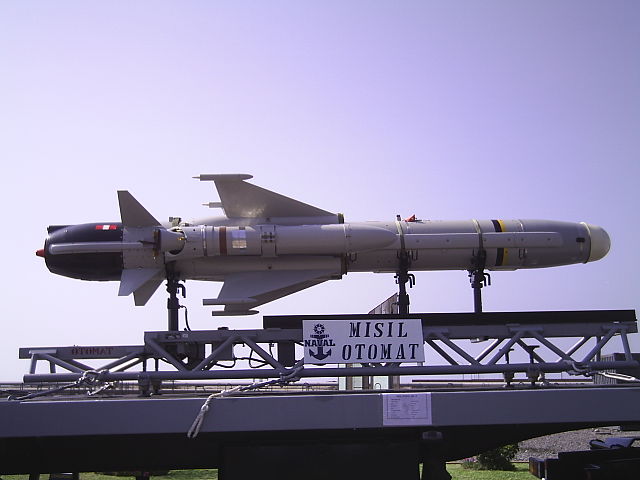
OTOMat Mark 2 missile used by the Italian cold war navy but also largely exported
The Kangaroo “Canguro” was a provisional heavy torpedo, using the German G-7e seeking system and Mk 44 torpedo (US-built), wire guided to the target. Also the A-184 was an heavy torpedo developed for ships as well as submarines, wire-guided, in the 1970s, and the improved A-244, alternative to the US-built Mark 44 and widely exported.
The A-290 was abandoned for a joint French-Italian system called Impact. The Menon was a common ASW mortar, similar to Limbo and weapon alfa, with the same philosophy. It became widespread in the Italian navy, in single or three-barrel versions depending on the available space. Barrels were 32 cm x 4,6 m long barrels fired a 140 kgs charge. It was rippled-fire to produce a 80 x 180 yards zone of attack.
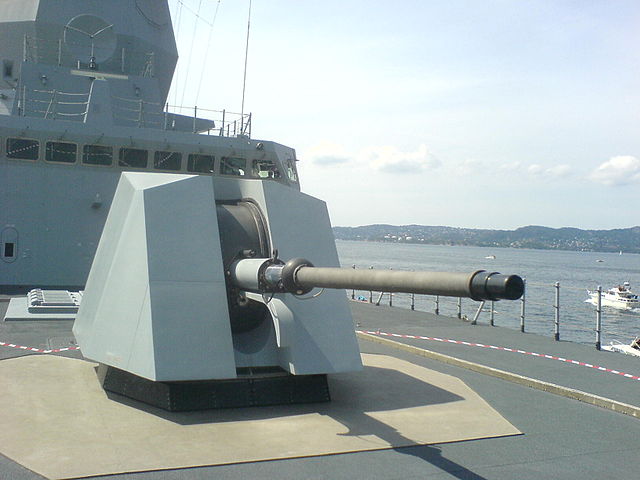
The famous OTO melara 76 mm/62 Super Rapido, onboard DNS Nansen. A huge export success
In addition to the 76 mm/62, the second gun standard proper to the Italian navy was the 127 mm/54 (or 5in/54). The 76 mm was further developed into the Super Rapido capable of 120 rpm and alternative in export markets to the CIWS, Phalanx/Goalkeeper, as the main anti-missile, short range AA gun of choice.
The gun fire conventionally 76 mm rounds with proximity-fuses, equivalent to many more smaller rounds to make an impact. The alternative is the OTOBreda Fast-Forty, a 40 mm capable of 300 rpm, 600 rpm in twin mount configuration which is the one chosen in general. It became the staple of the Bundesmarine. Also OTO developed a 3-in(76 mm) with the twin mount being vertical, the two barrels mounted on top of the other with the elevation mechanism in between. They appeared only on the Centauro class escorts.
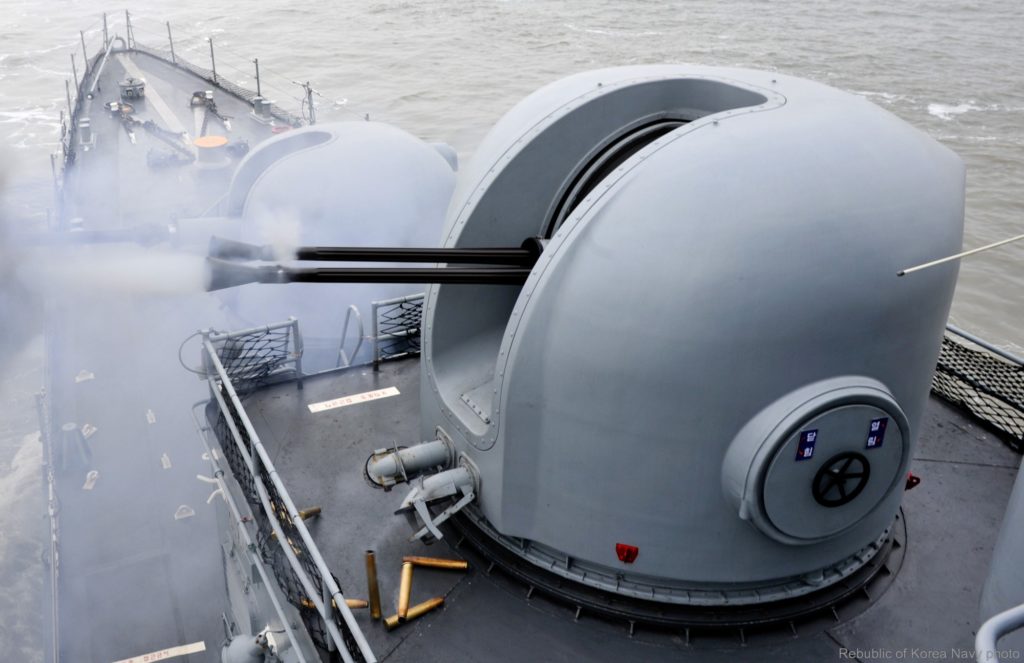
OTO-Malara 40 L70 Dardo
Complete Nomenclature of the Marina Militare
Battleships
Post-war, battleships were no longer the order of the day, and the last ones were discarded in 1956, not upgraded in any significant way and relegated to training.
These were the:
-Guilio Cesare: The ship became a war reparation to USSR, renamed Z11. She was renamed Novorrossiisk but records are shaky about her fate. She was more likely hit by a mine and sunk at Sevastopol on 28 October 1955.
-Andrea Doria & Caio Duilio: Both battleships were used as training vessels except Duilio which acted as flagship C&C of the Regia Marina for some time. Doria joined the reserve in 1953, followed by Duilio in 1954. Both were discarded in 1956.
-Italia & Vittorio Veneto: The ex-Littorio warhips still had fighting value in 1946 when they were returned from custordy in Malta to the Italians. This was short term as the first was attributed as war reparation to the US and scrapped in 1948-55 while Veneto was attributed to UK and scrapped 1948-51.
Cruisers
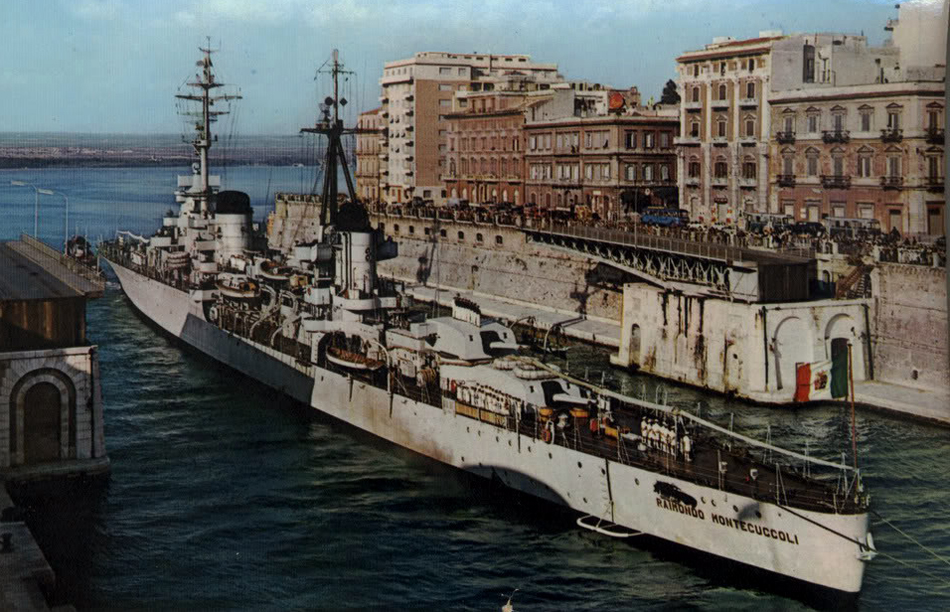
Montecuccoli in 1960 as a cadet training ship, she has been modernized, but this is often visible at the front and seeing the tops. Source
Training Cruisers and war reparations
No less than ten cruisers were still in the Italian arsenal after the war. They underwent various fates, some given a reparations, a few modernized and one completely refitted and overhauled.
-Luigi Cardona: The Cadorna became a training ship but was laid up in reserve by 1949 and discarded in 1951.
-Raimondo Montecuccoli: The 1934 cruiser had the chance of a significant modernization. She was indeed converted as a cadet training ship with a range of modifications between 1947 and 1949:
>’B’ turret removed, ‘Q’ position fitted with a twin 100mm/47 AA, 8x 40 mm AA (4×2), 4x 20 mm (singles), radar, and engines refit with new boilers for 75,000 hp and 29 knots. She served in this role until replacement by San Giorgio and was discarded in June 1964.
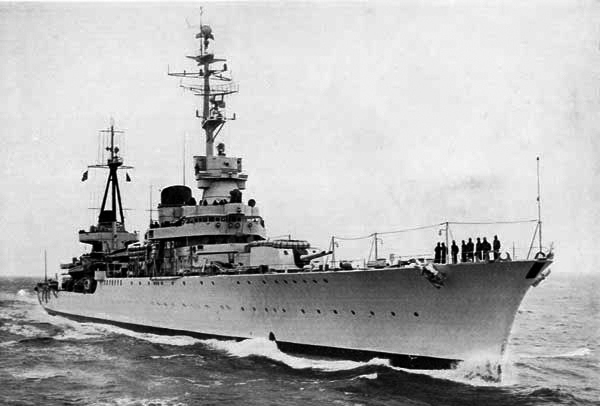
Montecuccoli in 1960, bow view showing most of the modernization changes.
-Duca D’Aosta & Eugenio di Savoia: The first was ceded as war reparation to USSR in March 1949. She was renamed Stalingrad, and later Kerch, and discarded in the late 1950s. Savoia was ceded as a war reparation to Greece, renamed Helle. She served a lot longer and was not discarded until 1964.
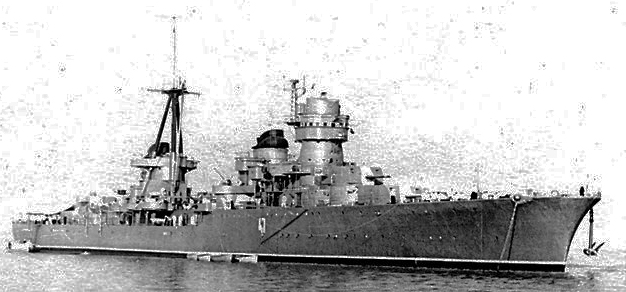
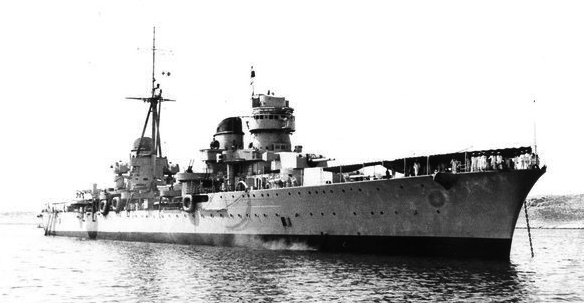
Soviet cruiser Kerch (top) repainted in dark grey and the Elli below as commissioned in 1951. She apparently underwent little modifications (retainining her original armament plus ten US-made Oerlikon 20mm guns, and the Italian postwar SO-8 radar and SK-2) until discarded in 1964 and auctioned off in 1973 to be broken up the same year. Source
Duca Degli Abruzzi class cruisers:
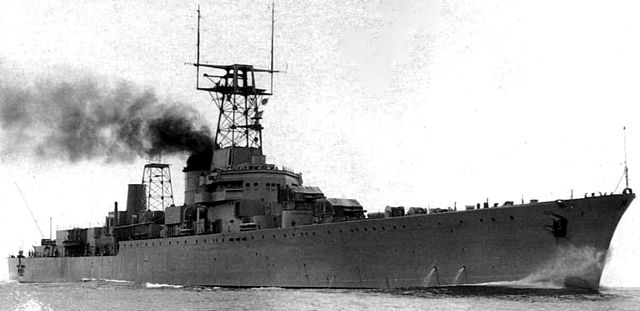
Garibaldi in 1960, after her second refit.
These two ships formed the backbone of the Italian Navy during the 1950s. Both were rebuilt extensively in 1950-53, and their secondary armament was now reduced to four 100mm/47 (2 x 2) and the light AA guns altered to 24-40mm (4 x 4, 4 x 2). Two of the eight boilers were removed reducing the power to 85,000shp for 29kts. The bridge was completely rebuilt also.
Garibaldi was modernised at La Spezia in 1949-51 and Abruzzi was more completely modified in 1951-53. Garibaldi emerged with US radars: The main SO-8 navigational set, fitted in a small radome atop her foremast, and a big SK2 on top of her mainmast. Abruzzi had her bridge structure considerably cut down and a tripod foremast stepped.
The latter supported a surface search radar (topmast) and the SK-2 was later replaced by the SPS-6C in 1955. An height-finder was installed atop the heavy mainmast until then fitted with a British Type 281 radar. Also a fire control radar was installed atop the main director forward. Duca Degli Abruzzi was decommissioned 30 April 1961 and discarded without further modifications.
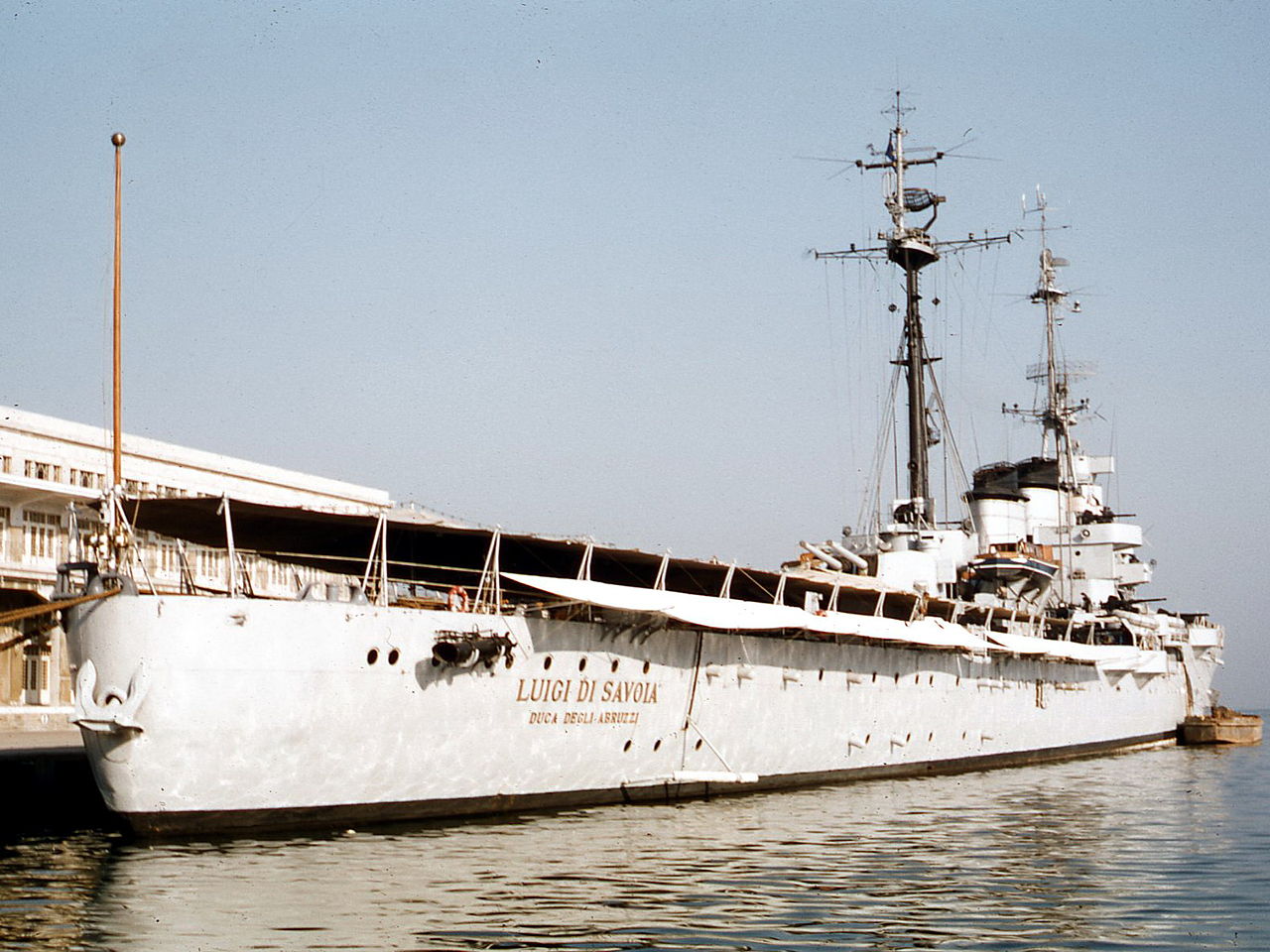
Luigi di Savoia Duca Degli Abruzzi at Trieste in 1959
Garibaldi however was rebuilt as a Terrier missile cruiser in 1957-61, with design work ready in 1954. Her forward turrets were deposed and replaced by brand new twin rapid-fire (80 rpm) 135mm/45 AA DP guns later replaced by 135mm/53 in 1968. Eich single 76mm/62 were fitted, four on each side.
The Terrier launcher replaced both after turrets with completely rebuiklt suprestructure for reloading and housing the missiles below. A lattice foremast was installed to carry a heavier aerial SPS-39 3-D radar, while an SPS-6 and surface search radar were added to its forward face. Another lattice was installed inmast, carrying a massive locally-built ARGO-5000 long-range air-search radar.
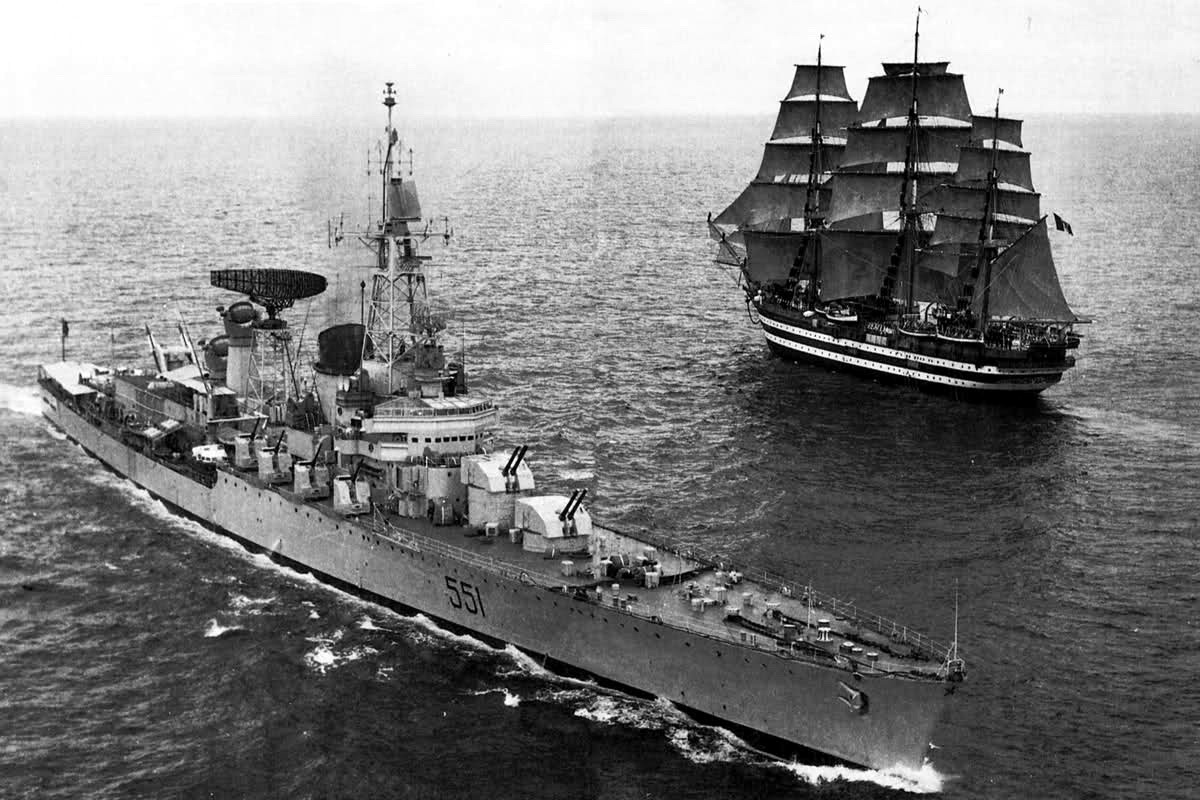
For the record: Nice photo showin the Garibaldi and Vespucci off Naples in 1968
American-built SPG-55 missile guidance radars were mounted aft of the missile launcher. A radar-equipped director, also Italian, was hounted above the bridge, with two more on each side of the superstructure to control the 76mm guns QF guns.
Terrier missiles were stowed below the twin launcher aft just like the early missile converted cruisers such as the USN Boston and Canberra. Later Terrier ships all had their missiles stowed horizontally and rammed the same way rather than vertically on to the launcher. For the rest, the systems were identical, with a magazine capacity of seventy-two vectors.
In addition Four Polaris ballistic missile tubes were sunk into the deck abaft the Terrier magazine. They were part of a larger US programme to distribute Polaris to trusted NATO allies. It happened when the United States had placed Jupiter ballistic missiles in Italy, while Polaris were considered a sea-going equivalent.
After the 1962 Cuban Missile Crisis however Jupiters were withdrawn and the Polaris idea was not further developed. The ships in fact onlt tested dummy missiles, as the Polaris which were never delivered. After all these modifications and the internal space sacrificed, the two funnels were reduced to one, with only four (but rather larger) boilers for a total of 85,000shp and 30kts (three less). Electrical generating power was increased to 4500kW. Garibaldi was decommissioned 20 February 1971 and stricken 16 Nov. 1976.
The ‘Capitani’ in the cold war
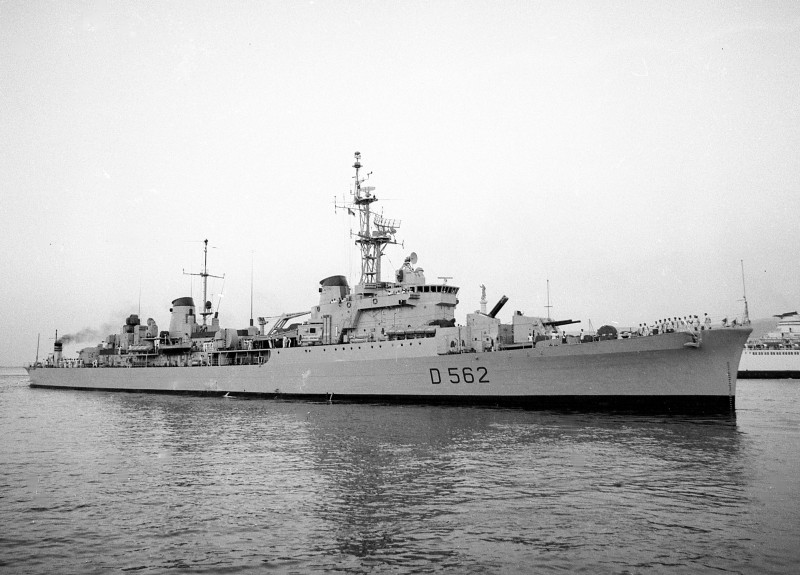
San Giorgio (D562) – src shipspotting.com
Very symbolic of the last desperate measures a the fascist regime to bolster the Regia Marina, an entire class of “destroyer killers” was built during the war, cut short by the capitulation of 1943. The ‘Roman captains’ were still four in service, recent and relavitely untested, ready to be converted as escorts.
Africano and Regolo were given as war reparation to France, renamed Guichen and Chateaurenault, and completely rebuilt. Both were dscarded in 1962 and 1962.
Germanico was scuttled on 29 August 1943 before she was completed, but she was salvaged in 1947. Both she and Pompeo Magno were rebuilt during 1951-55 with American weapons and radar. Their existing armament was replaced by 6 127mm/38 (3 x 2) in ‘A’, ‘X’ and ‘Y’ positions and 20 40mm AA. In ‘B’ position.

San Giorgio profile in 1978 (serc navypedia)
They also had an Italian Menon triple ASW mortar. Renamed Marco and San Giorgio respectively and were recommissioned in 1956. In 1957 they were re-rated from cruisers to scouts and in 1958 from scouts to destroyer leaders. Both received US-supplied sensors: SPS-6 and SG-6B radars and SQS-11 sonar, the same sets as in the first postwar destroyers and escorts.
The 5in fire control system was the US Mk 37, with Mk 25 radars. They were given the pennant the number D 562 (San Giorgio) and D 563 (San Marco). The latter was scrapped in this condition, but San Giorgio was completely rebuilt as a cadet training ship during 1963-65.
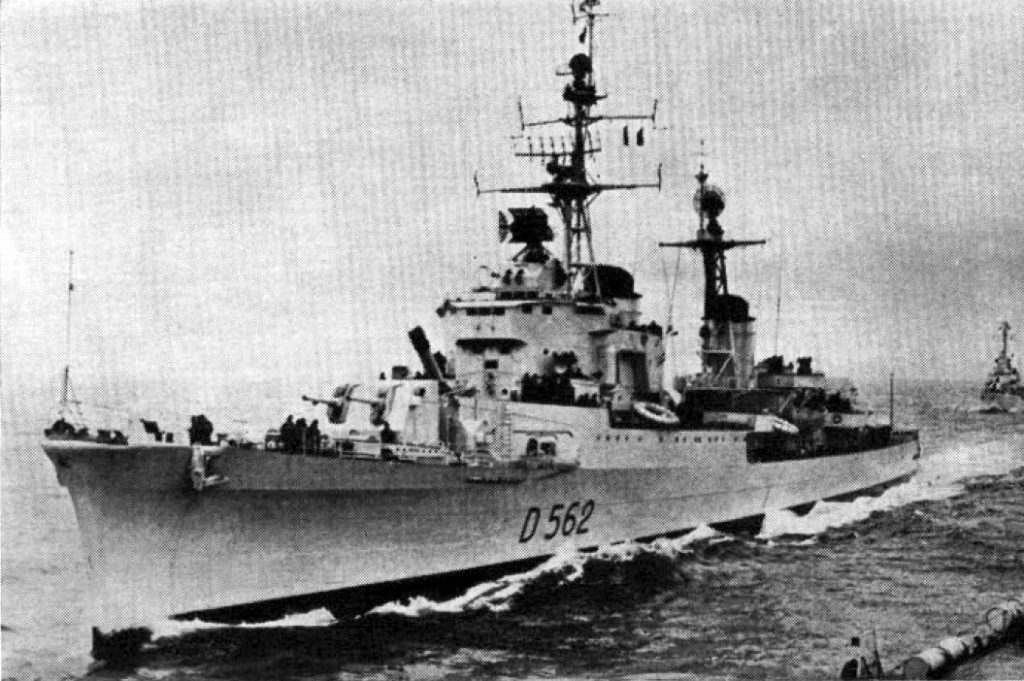
San Marco underway circa 1959 – src unknown. Plan Photo
San Giorgio was fitted with CODAG machinery (2 Tosi Metrovick G 6 gas turbines, each of 7500shp, and 4 Fiat-Tosi diesels each of 4000bhp) on two shafts, giving a maximum speed on diesels alone of 20kts and combined of 28. She had new funnels, the second being set much farther aft, and was given accommodation for 130 cadets.
‘X’ position 127 mm was replaced by a single 76mm/62 and two more single 76mm/62 fitted amidships, while all the old Bofors 40mm were removed. Also two triple modern ASW 324mm TT banks were installed. San Marco also received the SPS-2 radar and Orion RTN-7X fire control radars for her AA artillery.
Modernized destroyers
The oldest one (outside ww1-era DDs reclassified as TBs) was the Navigatori-class Nicoloso da Recco (1930) which was worn-out in 1950, her engines only capable of 28 knots. She was not modernized and scrapped in 1955.
The Grecale, of the Maestrale class (1934) was taken in hands in 1949 for a Modernization:
-British destroyer type bridge
-Lattice mast and modern navigation radars and FCS
-Three 37 mm guns, later 6x 40 mm, no TTs (removed 1952)
Classed as a frigate in 1957 she was converted into a command ship in 1959-60 with only two 20 mm guns, and CIC center. She acted as such until the modernized Garibaldi entered service and took her place. Grecale was discarded in January 1964.
The Alfredo Oriani (1936) of the Oriani class, was transferred to France (as D’Estaing) and served from 1948 (See French section);
The Soldati-class Artigliere, Carabiniere, Granatiere and Fuciliere (1937-38) knew different fates: Artigliere and Fuciliere becale soviet war reparations, transfered in 1949 anbd 1950 while the two others were modified in detail. They became ASW escorts after their refit in 1953-54:
-TT removed, AA removed, 6x 40 mm fitted.
-Bridge rebuilt
-Modern sonar and radar, new DC racks and DCTs.
They became both Frigates afterwards, and Carabiniere was modified to carry and operate the Italian ASW mortar called Menon system. She also was usd to test various types of weaponry and associated FCS. She became the experimenatal ship A5312 after 1960 and was eventually scrapped in 1965 while Granatiere was discarded in 1958.
Last of the wartime Soldati class (2nd group), the Legionaro, Mirragliere and Velite (1941) were all transferred to France in 1948 as Duchaffault, Jurien de la Gravière and Duperré, discarded in 1954, 1956 and 1961.
Former Torpedo Boats still in service
The oldest ships of these classes as stated above, were the WW1-vintage Pilo, La Masa, and Curtatone class. The three Pilo became minesweepers after modifications in 1953 (Abba and Mosto), discarded in 1958. Carini and Fabrizi of the La Masa class were also converted this way and discarded in 1957-58. The sole survivor of the larger Curtatone class was scrapped without modifications in 1957.
Interwar TBs of the Spica class also survived in numbers, seven ships in all; They became fast ASW corvettes. Modernization took place in 1952:
-TT removed, one 100 mm removed, 1 Hedgehog added
-Bridge modified, radar and new sonar added.
-2 x 40mm added (1958).
Sagittario was used to test various types of weaponry, and in 1958 for all survving ship the remainder 100mm/47 was removed.
The same modifications were applied to the Pegaso-class Orione and Orsa. These ships were discarded in 1959-64.
Two Ciclone class TBs were transferred as war reparation to USSR, and two others plus two Ariete class to Yougoslavia in 1949. The Yugoslavian ships were known as the Biokovo, Triglav, Ucka, Durmitor, Valebit (ex. Ta-46, never completed and BU).
Former submarines still in service
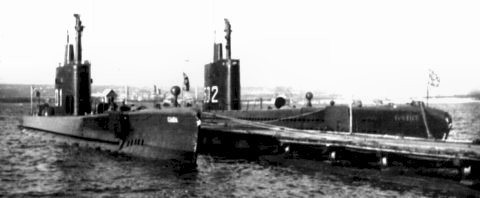
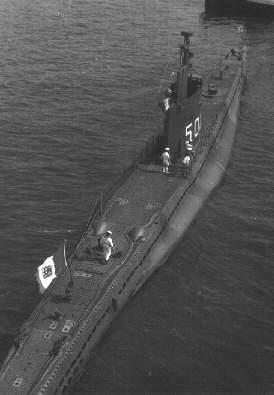 With the largest subarine fleet in the axis, the Regia Marina’s losses still left about 40 submarines operational when the war ended. The oldest by far were the H1 class, dating back from 1916. These ww2 Italian submarines were scrapped in 1947. More modern ones were still active for some time, but in such poor condition that any modernization program was considered useless. The Otaria (1939) was srapped in 1948, the Atropo, Zoea in 1947 as well as the Dandolo, Brin, Cagni, Romolo class, Mameli, Procida, Speri, Pisani, Bandiera, Manara, Menotti, Squalo, Brahadin, Corridoni, Settimo, Jalea, Galatea, Diaspro, Onice Turchese, Alagi, Giada, Platino and most midget CB types.
With the largest subarine fleet in the axis, the Regia Marina’s losses still left about 40 submarines operational when the war ended. The oldest by far were the H1 class, dating back from 1916. These ww2 Italian submarines were scrapped in 1947. More modern ones were still active for some time, but in such poor condition that any modernization program was considered useless. The Otaria (1939) was srapped in 1948, the Atropo, Zoea in 1947 as well as the Dandolo, Brin, Cagni, Romolo class, Mameli, Procida, Speri, Pisani, Bandiera, Manara, Menotti, Squalo, Brahadin, Corridoni, Settimo, Jalea, Galatea, Diaspro, Onice Turchese, Alagi, Giada, Platino and most midget CB types.
while Bronzo was sent to the French Navy as war reparation, like the Nichelio, Marea (USSR), Nautilio (Yugoslavia). Perla was captured and served as the Greek Matrozos. A single CB and a CM type submarines were preserved in 1951. Two of the unfinished Romolo class were completed as floating tankers and served for 20 more years. Acciaio and Giada served as training submarines and later battery chargers (PV-1 & PV2). The treaty “no submarine” was removed in 1951 and both were returned under their original name in service, modernized:
Giada class training submarines (1953)
The Giada and Vortice were rebuilt between 1951 and 1953: Teir hull was streamlined, the gun was elminated. They were eventually discarded in 1966-67.
Pietro Calvi (1959) >
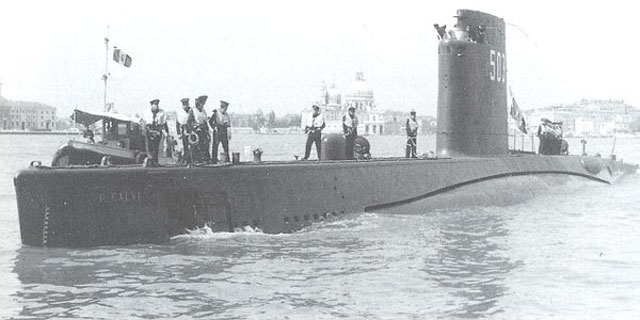
This sister-boat of the Vortice (Class Flutto type II) Bario, was taken in hands for completion under a completely different design. Originally she has been never completed, was captured and then scuttled by the Germans in 1945. She was salvaged and stored, waiting her fate. When the submarine ban was lifted in 1951, but unlike the former Vortice, she waited for a more comprehensive reconstruction which took place between 1957 and 1961. She was relaunched on 21 June 1959, and renamed and re-commissioned as Pietro Calvi (S 503).
Her new specifications were as such:
Displacement: 905/1107 tons
Dimensions: 66 x 7 x 4 m (216 x 23 x 13 feets)
Machinery: 1 shaft coupled to two MAN diesels and three electric motors (all new): 2700 hp/? shp on electric power
Speed: 14 knots surface as diving.
Armament: Four 533 mm TTs
Complement: 60
Former corvettes still in service: Gabbiano class
Relatively spared by the war, 22 ASW corvettes of the Gabbiano class survived. These constituted the largest homogeneous class in service and were not hampered by any treaty, so they were hard-pressed for patrolling the Italian seas after the war, and served until a large reconstruction program took place from 1952.
The program already had a some “pre-serie prototypes” to come along: The three uncomplete ships Bombarda, Crisalide and Farfalla has been captured by the Germans, little work done, before they were scuttled in 1945. It was decided postwar to convert them into more modern ASW corvettes, with one 100mm/47, 3-20mm/70 AA, two twin 20 mm/65 AA (Oerlikon and Breda), two 450 mm TTs, 8 DC throwers and two stern racks with six depht charges each plus two towed DCs. The tubes, landed at some point and later remounted fired a local Italian Whitehead torpedo W200, 5.73 m long, 930 kgs.
The 1952-56 all other ships were converted and modernized. All received a brand new rebuilt bridge, in the British style with angled sides, CiC and open bridge. Modernization of the armament followed the lines of the previous postwar boats, and they were split in two groups, those with a AA escort role and SPS-6 search radar, and the ASW escort group with OS-13 search radar and Italian NSM-8 search radar, and an armament of two twin 40 mm/56 AA conducted by an Mk 51 FCS each. The ASW variants comprised a hedgehog mortar Mark 10 abaft the forward 40 mm AA, four short Menon ASW mortars, single DC track aft, two 450 mm TTs of the type decribed above.
They carried 144 hedgehog rounds, 68 Menon bombs and operated an US-supplied QCU-2 sonar. Pomona and Sibilla tested heavy two-layers DC tracks at the stern for 24 Mark 6 depht charges in all. Gabbiano and Bombarda were later simplified, with the forward 40 mm removed, aft 40 mm, two 20 mm AA alongside the bridge structure, four Menon ASW DCTs aft, and short simple DC tracks. They also had provisionally a 100 mm gun, later removed for a Mark 15 Hedgehog.
Group I AA escorts Cormorano and Danaide with SPS-6 radar had a different, large deckhouse forward of the bridge, no hedgehog, and Sfinge mounted a 100mm forward, but she was later rearmed and received in addition a hedgehod and forward 40 mm AA. It was the same for Driade and Flora. However in 1956 Ape was disarmed (but for two 20 mm AA guns) and converted as a diver’s base, commando frogmen transport.
The group II ASW escorts (Baionetta, Farfalla, Gru, Ibis, Minerva, Scimitarra, Urania, Crisalide) were given a SO-13 radar, with the exception of Baionetta which had an NSM-8 surface radar. They were armed with three 40 mm and trainable mark 15 stabilied Hedgehog forward, and same 450 mm TTs, Menon projectors, but later they received the heavy two-layer DC tracks of the Pomona. In 1953, Farfalla was a forward 100 mm and no hedgehog, added in 1956. These 660 tons ships were discarded circa 1965 to 1977 (Bombarda), making most of their wartime construction.
Miscellaneous ships still in service
-Outside the ASW corvettes/escorts, a single ship of relatively large size, 3068 tons in displacement was still extant aftert the war: The colonial sloop Eritrea. Dating back from 1936 she has been mostly inactive during the war and was attributed as war reparation to France, renamed Francis Garnier. She served as a gunboat and was discarded in 1960.
-The only gunboat to survive wartime was the Ernesto Giovanni (1922). This 206 tons vessel was converted as a minelayer and served also as a patrol boat, discarded in 1950.
-The Italian Navy also had at its disposal a large fleet of minesweepers: The ww1-vintage RD class, mostly distributed to Yugoslavia as war reparation in 1948 but four which were discarded in 1953-56.
NATO/MDAP Transferred ships to Italy
Corvettes
-Acquired in 1949, the Flower-class corvette Stafetta (ex-Elbano, ex. USS Prudent, ex. HMS Privet), discarded in 1970, rearmed with two 20 mm and later converted as hydrographic vessel.
-Alabarda (1946), the Lobniz built Larne (Algerine class) minesweeper served as a corvette, under the names Ammiraglio Maraghi, then Eritrea, and then Alabarda, under which she was discarded in 1968. She has been rearmed as an ASW corvette with one 4-in/47 forward, four 37 mm guns, four Menon ASW mortars, and 2 DC racks aft. Divisional flaghsip for corvettes she received a deckhouse in place of her forward 4 in gun.
–Vedetta: Also under MDAP, Italy received in 1954 the PC 1916. The French-built PC Type for Germany was later diverted to the Ethiopian Navy in 1957 and when judged too advanced for it, transferred to Italy. She became Vedetta in 1959 and served as a corvette, then fishery protection vessel, discarded in 1977. In appearance she was closed to the US PC Type coastal ASW patrol ship, but with French construction differences.
Coastal minesweepers
-The other large classes were allied vessels given to the Italians in 1947, such ase Azalea and Anemone class coastal minesweepers (Type USN YMS, 215 tons, converted), 17 in all, mostly discarded in 1966 or passed to the customs for two (Dalia and Begonia). In 1956 their original 76 mm gun was replaced by a 20 mm AA.
-These were also 4 Dance, a single Shakespearian ship and 11 Isles class minesweepers transferred by the British Navy in January-March 1946. They received 3x 20 mm in 1956 and their 76 mm was removed. They were discarded in 1962 and became auxiliaries.
-The Marina Militare also received 16 former ‘DV’ class 110 tons coastal boats. Reclassified as Motor patrol boats in 1955, some refitted with lattice masts, two became disarmed survey vessels (discarded from the navy list), the other were discarded in 1957-59.
Transferred Minesweepers
In service during the cold war were:
-3 daino class minesweepers (ex-German, coal, later converted to oil burning, M1940 types launched 1943, USN 1947, back Italy 1949). Armed with 3.9 in, 3x 40mm AA, DCT. Antelope discarded 1958, two others converted to corvettes 1959, Daino survey ship 1960, Gazzela cadet TS. Discarded 1966.
-4 Salmone class ocean minesweepers (ex-US Agressive class). Transferred MDAP 1955, discarded 1990-91, two converted as fishery prot. vessels (extant).
-17 Acacia class coastal Minesweepers (ex-Adjutant class, transferred MDAP Dec. 1960). Some had a modified bridge and funnel. Discarded 1990s.
MTBs
A large numbers of Italian motor torpedo boats or patrollers re-entered service with the Marina Militare. The MAS however fell under the terms of Italian disarmament treaty and most that were not sent as war reparations (France: 2, USSR: 3) were disarmed or converted to other uses. The oldest like the MAS 430 were discarded in 1949, MAS-438 and 501 in 1950. The Motovidette (MV) had no TTs, but two to six 20 mm guns, or became simple harbour crafts after being discarded.
The larger MS boats were also partially disarmed, loosing their TTs. These were four boats of the 1st serie (MS I) and 11 of the second (MAS-II). They were also the VAS of two series (16 in all). In all, seven were sent as war reparation to USSR, one to France, and the remainder received new TTs in 1952-53. Four were converted as modernized MGBs in 1960. They were given new engines for 4500 hp (33 knots), carried two 20 mm AA, one 40 mm AA, two 450 mm TTs, and could carry mines. These four were discarded in 1963-65 and 1978, the others in 1953-57.
The VAS ships were used mainly as coastal minesweepers and were discarded in 1953-57.
Also were transferred under MDAP many MTBs:
-SIS class: 12 Vosper Type in 1948, reconstructed 1949-52, armed with 5x 20 mmAA, 2x 450 mm TTs, discarded 1958-61.
-GIS class: 8 Higgings boats in 1948, also refitted for service with 1x 40mm, 2/3 x 20mm AA, 2x 450 mm TTs. Recontructed 1961 with a SPS-21 radar, ASM-185 engines (34 knots). Discarded from 1966, converted for customs of divers support, last discarded circa 1985.
-MS 621: A single ex-S 701 S-Boat refitted in 1953: 2x 20 mm AA, 2 TTS 450 mm. She was renamed MC 485 and was discarded in 1965.
LSTs
The Marina Militare still operated 14 old MFP-D class, built in Italy on German plans for the planned invasion or Malta that never took place. They were still in pristine conditions and 9 remained in service until 1981, some even making it on the list in reserve until …1995 !
Also transferred after the war by the USN and Royal Navy in 1947 were 10 LCT(3). Five were still in service years after, converted as lighthouse tenders or repair crafts. They were discarded also in the 1990s. It should be noted that gradually, the Marina Militare acquired many more landing ships from the USN as they were retired: 20 LCM(3) & LCM(6), 30 LCVP, 6 LSSL. The two first series in 1952-53 and 1952-72, and the LSSLs under MDAP plan in July 1952.
Misc. ships
Andrea Bafile L9871: Ex- USS St. Georges, Kenneth Whiting class support ship. Trasnferred December 1968, stricken 1995.
Pietro Cavezzale A 5301: Ex- USS Oyster Bay, Barnegat class tender, transferred under MDAP in 1957.Used as frogmen support ship, misc. ship and depot, stricken 1994.
Ships to come (individual posts)
> Raimondo Montecuccoli – Training cruiser (1960)
> San Giorgio class -Rebuilt escorts (1958)
> Luigi Durand de la Penne class destroyers (1989)
> Canopo class Frigates (1954)
> Bergamini class Frigates (1960)
> Alpino class Frigates (1967)
> Lupo class Frigates (1976)
> Maestrale class Frigates (1981)
> Ex-US Submarines in Italian service (Gato/Balao GUPPY, Tang)
> Toti class submarines (1965)
> Sauro class submarines (1976)
> Pelosi class submarines (1986)
(Laid down 1991: Longobardo class submarines)
> Quarto class LST (1967)
> Grado class LSTs (ex. USN De Soto Cty acquired 1981, stricken 1988-89)
> San Marco class DLSs (1987)
> MTM 217 class (LCM type 1987) for San Marco class
> Albatros class corvettes (1954)
> De Cristofaro class corvettes (1964)
> Minerva class corvettes (1987)
(Laid down 1989): Cassiopeia class corvettes
> Patrol Boats Folgore class (1950-65)
> Sparviero class hydrofoils (1973)
> Agave class coastal minesweepers (1955)
> Aragosta class inshore minesweepers (1955)
> Lerici class minehunters (1982)
(In construction: Gaeta class minehunters)
Sources/Read More
John Gardiner – Conway’s all the worlds fighting ships 1947-1995
//www.meretmarine.com/fr/content/la-marina-militare-italienne
//www.marina.difesa.it/Pagine/Default.aspx
//www.sommergibili.com
//www.tarantobuonasera.it/
//webtv.marina.difesa.it/
//en.wikipedia.org/wiki/List_of_decommissioned_ships_of_the_Italian_Navy
//en.wikipedia.org/wiki/Allied_Joint_Force_Command_Naples
//www.edrmagazine.eu/an-analysis-of-italian-navys-frontline-ship-development
//www.naval-technology.com/?s=italian+
//www.navalanalyses.com/search/label/Italian%20Navy
//www.defensenews.com/search/59207420/?q=italian+navy
//youtu.be/P8osIpj8cRM


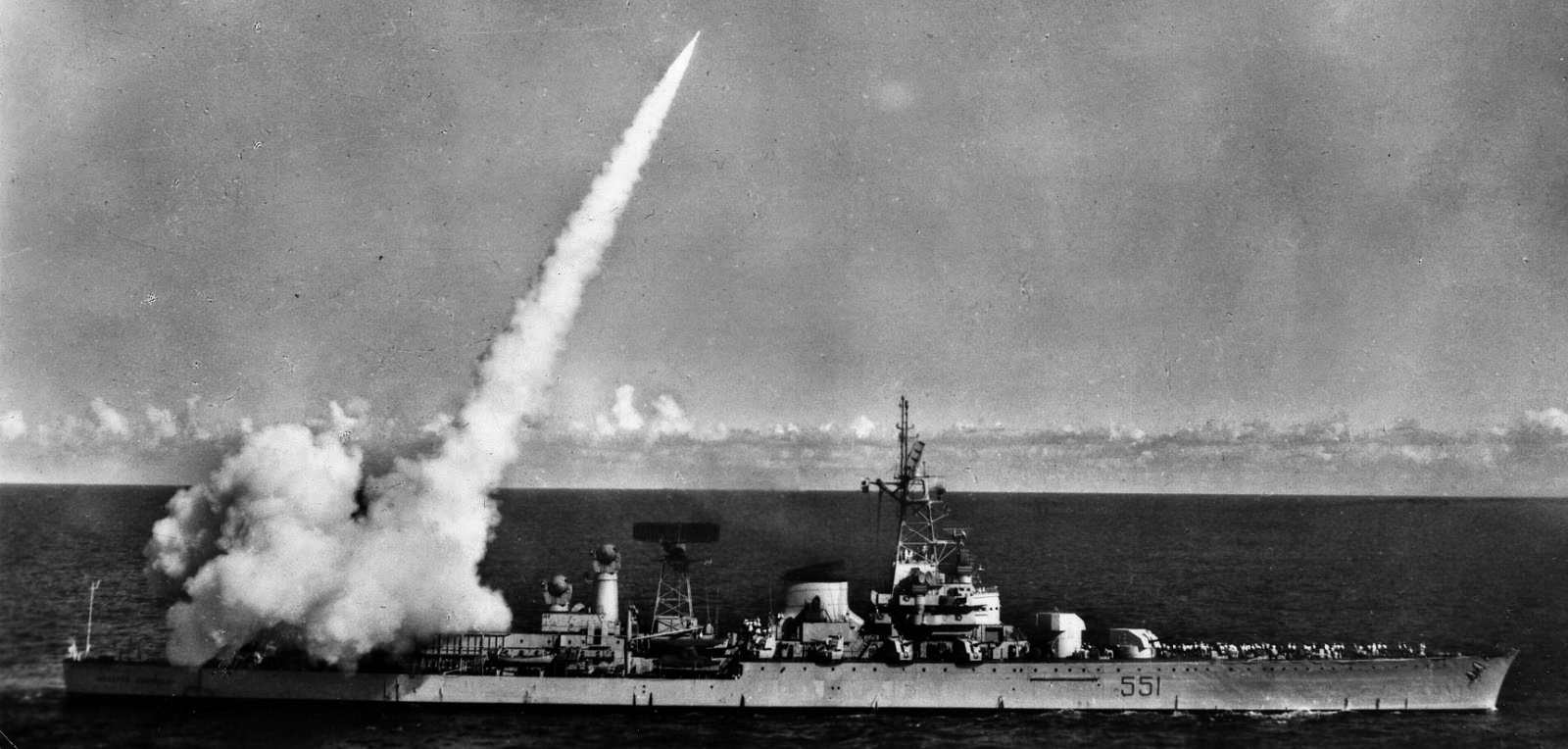
 Latest Facebook Entry -
Latest Facebook Entry -  X(Tweeter) Naval Encyclopedia's deck archive
X(Tweeter) Naval Encyclopedia's deck archive Instagram (@navalencyc)
Instagram (@navalencyc)





 French Navy
French Navy Royal Navy
Royal Navy Russian Navy
Russian Navy Armada Espanola
Armada Espanola Austrian Navy
Austrian Navy K.u.K. Kriegsmarine
K.u.K. Kriegsmarine Dansk Marine
Dansk Marine Nautiko Hellenon
Nautiko Hellenon Koninklije Marine 1870
Koninklije Marine 1870 Marinha do Brasil
Marinha do Brasil Osmanlı Donanması
Osmanlı Donanması Marina Do Peru
Marina Do Peru Marinha do Portugal
Marinha do Portugal Regia Marina 1870
Regia Marina 1870 Nihhon Kaigun 1870
Nihhon Kaigun 1870 Preußische Marine 1870
Preußische Marine 1870 Russkiy Flot 1870
Russkiy Flot 1870 Svenska marinen
Svenska marinen Søværnet
Søværnet Union Navy
Union Navy Confederate Navy
Confederate Navy Armada de Argentina
Armada de Argentina Imperial Chinese Navy
Imperial Chinese Navy Marinha do Portugal
Marinha do Portugal Mexico
Mexico Kaiserliche Marine
Kaiserliche Marine 1898 US Navy
1898 US Navy Sovietskiy Flot
Sovietskiy Flot Royal Canadian Navy
Royal Canadian Navy Royal Australian Navy
Royal Australian Navy RNZN Fleet
RNZN Fleet Chinese Navy 1937
Chinese Navy 1937 Kriegsmarine
Kriegsmarine Chilean Navy
Chilean Navy Danish Navy
Danish Navy Finnish Navy
Finnish Navy Hellenic Navy
Hellenic Navy Polish Navy
Polish Navy Romanian Navy
Romanian Navy Turkish Navy
Turkish Navy Royal Yugoslav Navy
Royal Yugoslav Navy Royal Thai Navy
Royal Thai Navy Minor Navies
Minor Navies Albania
Albania Austria
Austria Belgium
Belgium Columbia
Columbia Costa Rica
Costa Rica Cuba
Cuba Czechoslovakia
Czechoslovakia Dominican Republic
Dominican Republic Haiti
Haiti Hungary
Hungary Honduras
Honduras Estonia
Estonia Iceland
Iceland Eire
Eire Equador
Equador Iran
Iran Iraq
Iraq Latvia
Latvia Liberia
Liberia Lithuania
Lithuania Mandchukuo
Mandchukuo Morocco
Morocco Nicaragua
Nicaragua Persia
Persia San Salvador
San Salvador Sarawak
Sarawak Uruguay
Uruguay Venezuela
Venezuela Zanzibar
Zanzibar Warsaw Pact Navies
Warsaw Pact Navies Bulgaria
Bulgaria Hungary
Hungary

 Bundesmarine
Bundesmarine Dutch Navy
Dutch Navy Hellenic Navy
Hellenic Navy Marina Militare
Marina Militare Yugoslav Navy
Yugoslav Navy Chinese Navy
Chinese Navy Indian Navy
Indian Navy Indonesian Navy
Indonesian Navy JMSDF
JMSDF North Korean Navy
North Korean Navy Pakistani Navy
Pakistani Navy Philippines Navy
Philippines Navy ROKN
ROKN Rep. of Singapore Navy
Rep. of Singapore Navy Taiwanese Navy
Taiwanese Navy IDF Navy
IDF Navy Saudi Navy
Saudi Navy Royal New Zealand Navy
Royal New Zealand Navy Egyptian Navy
Egyptian Navy South African Navy
South African Navy






























 Ukrainian Navy
Ukrainian Navy dbodesign
dbodesign